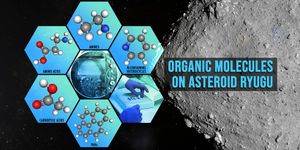Searching for Biosignatures on Mars and Other Planetary Bodies Using Artificial Intelligence-Machine Learning
Biosignature probability maps from convolutional neural network models and statistical ecology data. The colors for a) indicate the statistical probability of biosignature detections, and for b) an image of a gypsum dome geologic feature (left) with biosignature probability maps for various microhabitats (e.g., sand versus alabaster) within the dome. (Credit: M. Phillips, F. Kalaitzis, K. Warren- Rhodes)
Are we alone in the universe? If not, then how will we find life? Will we dig for it, or detect it with an instrument? What about using artificial intelligence-machine learning (AI/ML), which is already being used to detect exoplanets? This last method is what an international team of researchers led by the SETI Institute Carl Sagan Center and the NASA Ames Research Center are examining to search for life on Mars other planetary bodies throughout the Solar System.
For the study, the researchers collected more than 7.765 images and 1,154 samples and tested instruments to detect photosynthetic microbes that hide within the crystals, rocks, and salt domes located within Salar de Pajonales, which is located at the boundary between the Atacama Desert and Altiplano in Chile. They also used drones to link simulated data from NASA’s HiRISE camera to ground sampling, along with producing 3D topographical mapping to determine spatial pattern data.
These specific microbes give off pigments that represent a single biosignature on NASA’s Ladder of Life Detection. The researchers chose the location due to its high-altitude location, meaning the ultraviolet radiation is higher, along with the very dry and almost inhospitable environment, meaning it’s an excellent Mars analog.
The researchers then used this data to train an ML algorithm known as convolutional neural networks (CNNs) to identify the distribution rules and patterns so it could locate similar patterns in untrained data. Their results indicated a successful biosignature detection rate as high as 87.5% compared to less than 10% conducted by random searches, along with reducing the area required for conducting such a search by as high as 97%. Their findings indicate nonrandom distribution of microbial life at Pajonales that possessed a strong connection to available water supplies.
Orbit-to-Ground investigation of biosignatures in Salar de Pajonales, Chile, which is the terrestrial Mars analog study site. (b) drone view of the site with macroscale geologic features (domes, aeolian cover, ridge networks and patterned ground) in false color. (c) 3-D rendering of dome macrohabitats from drone imagery. (d) Orange and green bands of pigments of the photosynthetic microbial communities living in Ca-sulfate micro-habitats. (Credit: N. Cabrol, M. Phillips, K. Warren-Rhodes, J. Bishop and D. Wettergreen)
“Our framework allows us to combine the power of statistical ecology with machine learning to discover and predict the patterns and rules by which nature survives and distributes itself in the harshest landscapes on Earth,” said Dr. Kim Warren-Rhodes, who is a Senior Research Scientist at the SETI Institute, and lead author of the study. “We hope other astrobiology teams adapt our approach to mapping other habitable environments and biosignatures. With these models, we can design tailor-made roadmaps and algorithms to guide rovers to places with the highest probability of harboring past or present life—no matter how hidden or rare.”
Going forward, the researchers plan to conduct further tests with the CNNs to help predict distribution patterns for halite microbiomes and ancient stromatolite fossils with the same ML algorithms to better understand if other natural systems exhibit the same findings from this study. After that, the team will focus on hot springs, rocks in Dry valleys, and hot springs. As their database grows, hypotheses regarding life in extreme environments will be examined, along with inventorying important analog ecosystems on Earth.
“While the high rate of biosignature detection is a central result of this study, no less important is that it successfully integrated datasets at vastly different resolutions from orbit to the ground, and finally tied regional orbital data with microbial habitats,” said Dr. Nathalie A. Cabrol, who is the Director of the SETI Institute, and a co-author on the study. “With it, our team demonstrated a pathway that enables the transition from the scales and resolutions required to characterize habitability to those that can help us find life. In that strategy, drones were essential, but so was the implementation of microbial ecology field investigations that require extended periods (up to weeks) of in situ (and in place) mapping in small areas, a strategy that was critical to characterize local environmental patterns favorable to life niches.”
This study was conducted over a five-year period and collaboration with more than 50 team members from 17 organizations and opens doors for using AI/ML to help scientists search for biosignatures throughout the cosmos, and is already being used to study exoplanets.
How will AI/ML be used to search for life beyond Earth in the coming years and decades? Only time will tell, and this is why we science!
Sources: Innovation News Network, Nature Astronomy, SETI Institute
As always, keep doing science & keep looking up!










